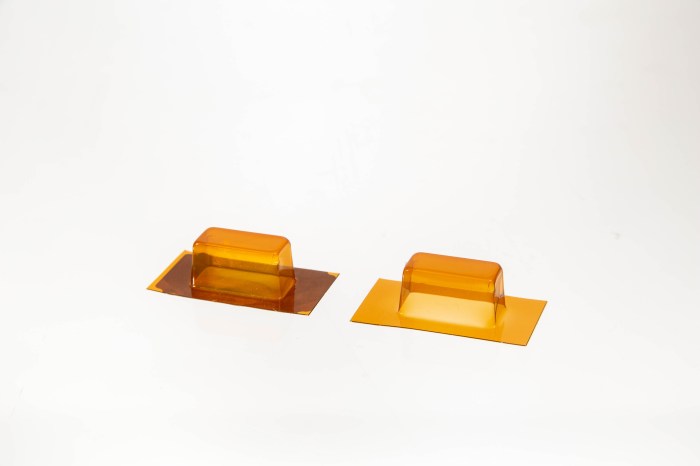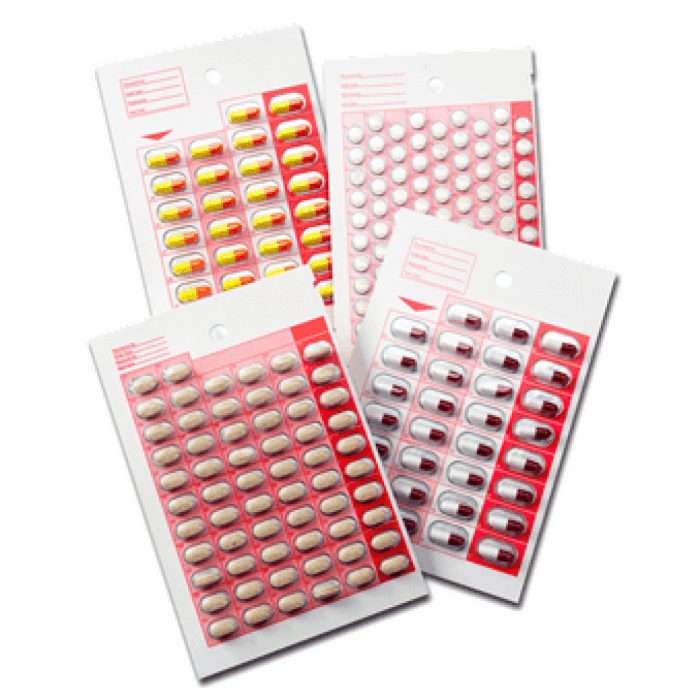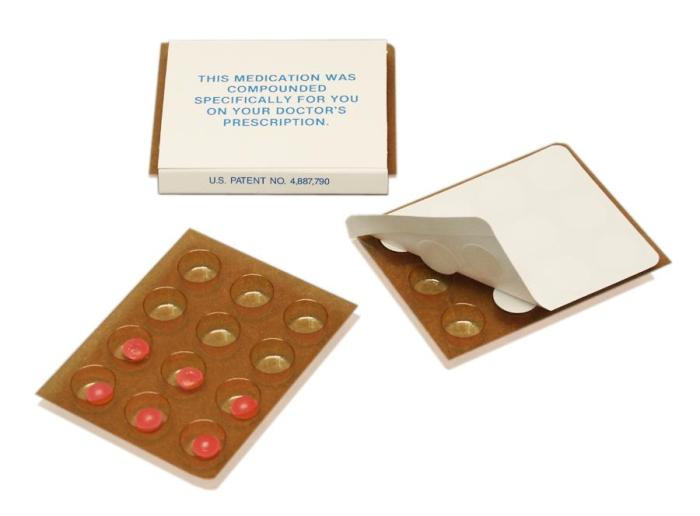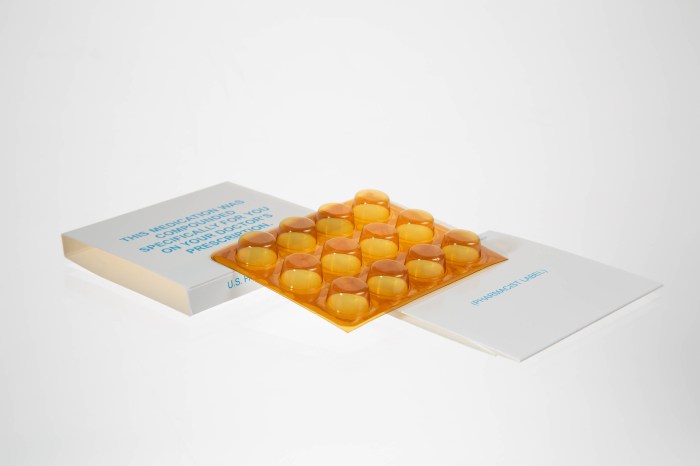Amber unit dose blister packs, indispensable tools in the healthcare industry, offer an innovative and reliable solution for medication management. Their unique design and amber tint play a crucial role in preserving medication integrity, ensuring patient safety, and promoting medication adherence.
Composed of high-quality materials, amber unit dose blister packs provide optimal protection against moisture, oxygen, and light. The amber tint effectively blocks harmful UV rays, safeguarding light-sensitive medications from degradation.
Product Overview

Amber unit dose blister packs are designed to store and dispense individual doses of medication safely and conveniently. They are typically made of a combination of materials, including plastic, aluminum foil, and paper.
The amber-colored plastic provides protection from light, which can degrade some medications. The aluminum foil acts as a barrier to moisture and oxygen, while the paper provides structural support and allows for easy identification of the medication.
Benefits
- Protect medication from light, moisture, and oxygen
- Enhance patient safety by ensuring accurate dosing
- Improve medication adherence by making it easy to track and dispense doses
- Reduce medication errors by providing a clear and organized system for dispensing
Drawbacks
- Can be more expensive than other packaging options
- May not be suitable for all types of medication
- Can be difficult to open for some patients
Pharmaceutical Applications

Amber unit dose blister packs play a crucial role in the pharmaceutical industry, offering protection and convenience for various medications.
One key application is the packaging of light-sensitive medications. Light exposure can degrade these medications, reducing their effectiveness and potentially leading to adverse reactions. Amber-colored blister packs block harmful UV rays, preserving the integrity of the medication and ensuring its potency.
Commonly Packaged Medications
- Antibiotics (e.g., amoxicillin, erythromycin)
- Antidepressants (e.g., fluoxetine, sertraline)
- Antipsychotics (e.g., risperidone, olanzapine)
- Hormonal medications (e.g., birth control pills, hormone replacement therapy)
- Eye drops and ointments
Medication Adherence
Amber unit dose blister packs also contribute to improved medication adherence. By providing pre-packaged doses, they simplify the medication-taking process, especially for individuals with complex medication regimens. The clear and organized format makes it easy for patients to track their medication intake and avoid missed or double doses.
Amber unit dose blister packs provide a convenient and secure way to dispense medications. They’re especially useful for patients who take multiple medications or have difficulty remembering to take their medications on time. Click here for more information on pogil cell size answer key.
These packs can help improve medication adherence and reduce the risk of medication errors. Amber unit dose blister packs are a valuable tool for ensuring that patients receive the medications they need, when they need them.
Packaging and Storage
Amber unit dose blister packs are filled and sealed using specialized machinery to ensure accurate dosing and protection of the medication. The process involves loading the blister pack into the machine, filling each cavity with the prescribed dose, and sealing the pack with a heat-sealed foil.
Storage Conditions
To maintain the integrity and efficacy of the medication, amber unit dose blister packs require specific storage conditions. These conditions typically include:
- Controlled temperature:The packs should be stored at a temperature range specified by the manufacturer, usually between 15-25°C (59-77°F).
- Protection from light:Amber-colored packs are designed to protect the medication from light degradation. They should be stored in a cool, dry place away from direct sunlight.
- Low humidity:High humidity can cause the blister packs to become brittle and compromise the seal. They should be stored in a controlled humidity environment.
Improper Storage Risks
Improper storage of amber unit dose blister packs can lead to several potential risks, including:
- Medication degradation:Exposure to excessive heat, light, or humidity can degrade the active ingredients of the medication, reducing its effectiveness or increasing the risk of side effects.
- Loss of potency:Improper storage can cause the medication to lose its potency over time, reducing its therapeutic efficacy.
- Compromised packaging:Extreme temperatures or humidity can damage the blister pack, leading to contamination or spillage of the medication.
Safety and Regulatory Considerations

Amber unit dose blister packs are designed with various safety features to ensure the integrity and safe dispensing of medications. These packs play a crucial role in preventing medication errors and maintaining patient safety.
Regulatory Requirements
The use of amber unit dose blister packs is governed by strict regulatory requirements to ensure their safety and effectiveness. These requirements vary depending on the jurisdiction, but generally include standards for the materials used, the manufacturing process, and the quality control measures implemented.
Role in Preventing Medication Errors
Amber unit dose blister packs contribute significantly to preventing medication errors by providing several key advantages:
- Individualized Dosing:Each blister pack contains a single dose of medication, eliminating the risk of accidental overdosing or underdosing.
- Clear Labeling:The packs are clearly labeled with the medication name, strength, and dosage instructions, reducing the chances of misidentification.
- Tamper-Evident Packaging:Blister packs are designed to be tamper-evident, making it easy to identify if the pack has been compromised before use.
Cost and Efficiency

Amber unit dose blister packs offer a competitive edge in terms of cost and efficiency compared to other packaging methods. Their cost-effective nature and potential for cost savings make them an attractive option for healthcare providers and pharmaceutical companies.
The use of amber unit dose blister packs can result in significant cost savings due to reduced medication waste and improved inventory management. By providing pre-packaged doses, these packs eliminate the need for manual counting and dispensing, reducing the risk of errors and the potential for over- or under-dosing.
Efficiency in Medication Management
Amber unit dose blister packs enhance efficiency in medication management by streamlining the dispensing and administration process. They provide a convenient and organized system for medication storage and dispensing, reducing the time and effort required for nurses and pharmacists. The pre-packaged doses ensure accurate and timely medication administration, improving patient safety and adherence to prescribed regimens.
Patient Perspectives: Amber Unit Dose Blister Pack

Amber unit dose blister packs offer several advantages for patients, including:
- Improved medication safety:The unit dose packaging helps prevent medication errors by ensuring that patients receive the correct dose of medication at the right time. The amber color of the blister pack also helps protect the medication from light degradation, which can affect its potency and effectiveness.
- Increased convenience:Unit dose blister packs are easy to carry and dispense, making it convenient for patients to take their medication on the go. The packs also help patients keep track of their medication intake, as they can easily see which doses they have taken and which doses are remaining.
Potential Drawbacks, Amber unit dose blister pack
While amber unit dose blister packs offer several benefits, there are also some potential drawbacks for patients to consider:
- Cost:Unit dose blister packs can be more expensive than traditional medication packaging, which may be a concern for patients on a budget.
- Environmental impact:The plastic used in unit dose blister packs can contribute to environmental pollution. However, some manufacturers are now offering biodegradable or recyclable blister packs to address this concern.
Overall, amber unit dose blister packs offer a number of benefits for patients, including improved medication safety and convenience. However, patients should also be aware of the potential drawbacks, such as cost and environmental impact, before making a decision about whether to use this type of packaging.
Innovations and Future Trends

The future of amber unit dose blister packs holds exciting advancements that promise to enhance patient safety, convenience, and adherence to medication regimens. Emerging trends in the development of these packs focus on incorporating innovative technologies and materials to improve functionality, sustainability, and personalization.
These innovations aim to address challenges faced by patients and healthcare providers, such as medication errors, medication waste, and the need for personalized dosing schedules. By embracing these trends, amber unit dose blister packs are poised to play an even more critical role in the healthcare industry.
Technological Advancements
One of the most significant trends in the development of amber unit dose blister packs is the integration of advanced technologies. These technologies include:
- Smart blister packs:Equipped with sensors that monitor medication usage and communicate data to healthcare providers, enabling remote patient monitoring and timely interventions.
- Electronic medication management systems:Integrate with amber unit dose blister packs to provide automated medication dispensing, reminders, and adherence tracking.
- Artificial intelligence (AI):Used to analyze medication usage patterns and identify potential medication errors or adherence issues, enhancing patient safety and medication optimization.
Sustainable Materials
Another emerging trend is the use of sustainable materials in the production of amber unit dose blister packs. These materials aim to reduce the environmental impact of medication packaging while maintaining the integrity and functionality of the packs.
- Biodegradable plastics:Derived from renewable resources, these plastics break down naturally, reducing waste and promoting environmental sustainability.
- Recyclable materials:Amber unit dose blister packs made from recyclable materials can be easily processed and reused, contributing to a circular economy.
Personalized Packaging
The future of amber unit dose blister packs also involves personalized packaging solutions that cater to the specific needs of patients. These solutions include:
- Customized dosing schedules:Amber unit dose blister packs can be designed to accommodate individualized medication regimens, improving adherence and reducing medication errors.
- Patient-centric designs:Blister packs can be designed with features that enhance usability for patients with dexterity or vision impairments, promoting independence and medication adherence.
Benefits of Innovations
The innovations in the development of amber unit dose blister packs offer numerous benefits for patients and healthcare providers. These benefits include:
- Improved patient safety:Advanced technologies and sustainable materials enhance medication safety and reduce the risk of medication errors.
- Increased convenience:Smart blister packs and electronic medication management systems simplify medication management and improve adherence.
- Reduced medication waste:Personalized packaging solutions and biodegradable materials minimize medication waste and promote sustainability.
- Enhanced healthcare efficiency:Automated medication dispensing and remote patient monitoring streamline healthcare processes and improve efficiency.
Future of Amber Unit Dose Blister Packs
The future of amber unit dose blister packs is promising, with ongoing innovations and advancements shaping the landscape of medication packaging. These packs will continue to play a vital role in the healthcare industry, supporting patient safety, medication adherence, and the efficient delivery of healthcare services.
Answers to Common Questions
What are the benefits of using amber unit dose blister packs?
Amber unit dose blister packs offer numerous benefits, including enhanced medication protection, improved medication adherence, reduced medication errors, and increased patient convenience.
How do amber unit dose blister packs protect medications?
Amber unit dose blister packs are made of high-quality materials that provide a barrier against moisture, oxygen, and light. The amber tint blocks harmful UV rays, preventing light-sensitive medications from degrading.
Are amber unit dose blister packs safe?
Yes, amber unit dose blister packs are safe for use in medication packaging. They meet all regulatory requirements and incorporate safety features to prevent medication errors.